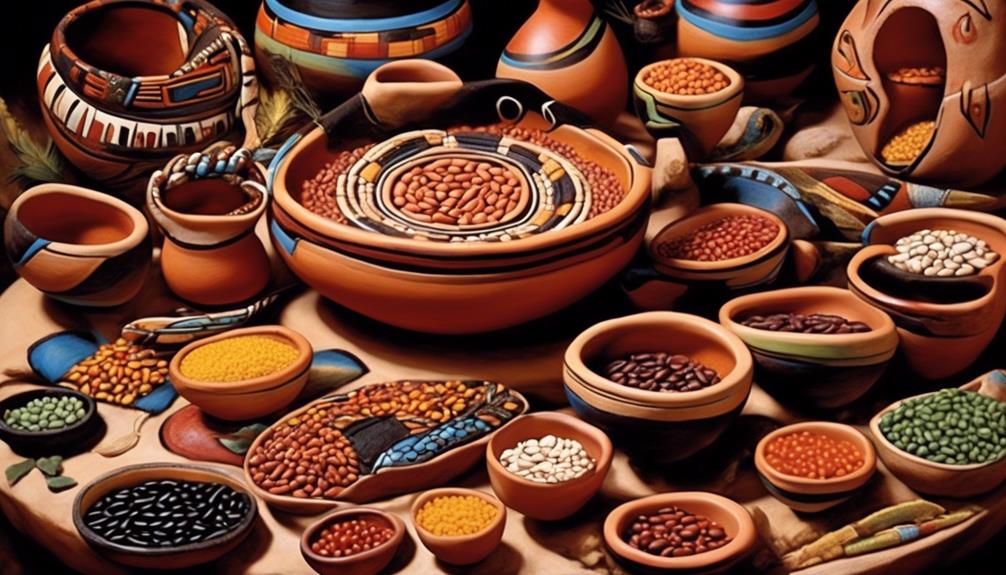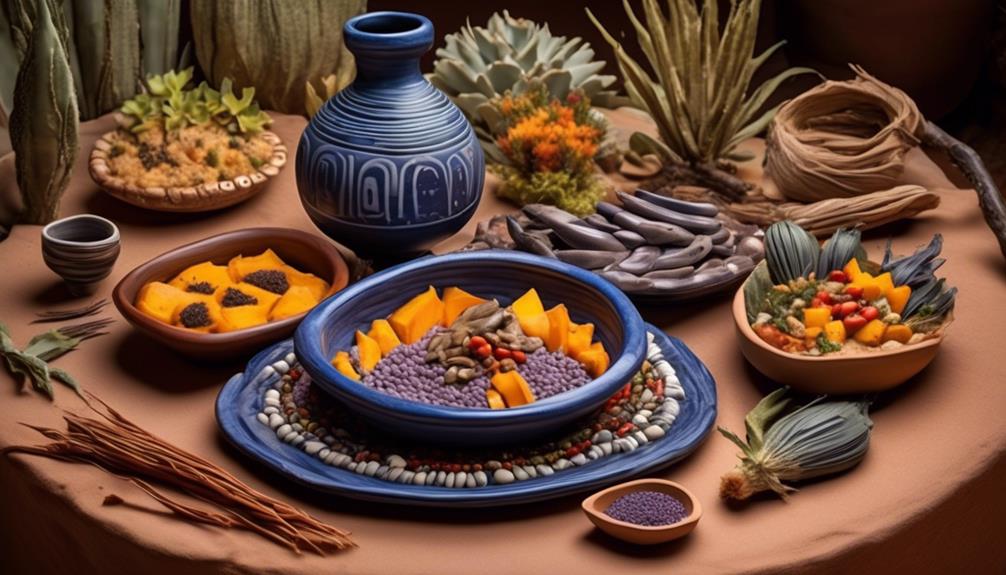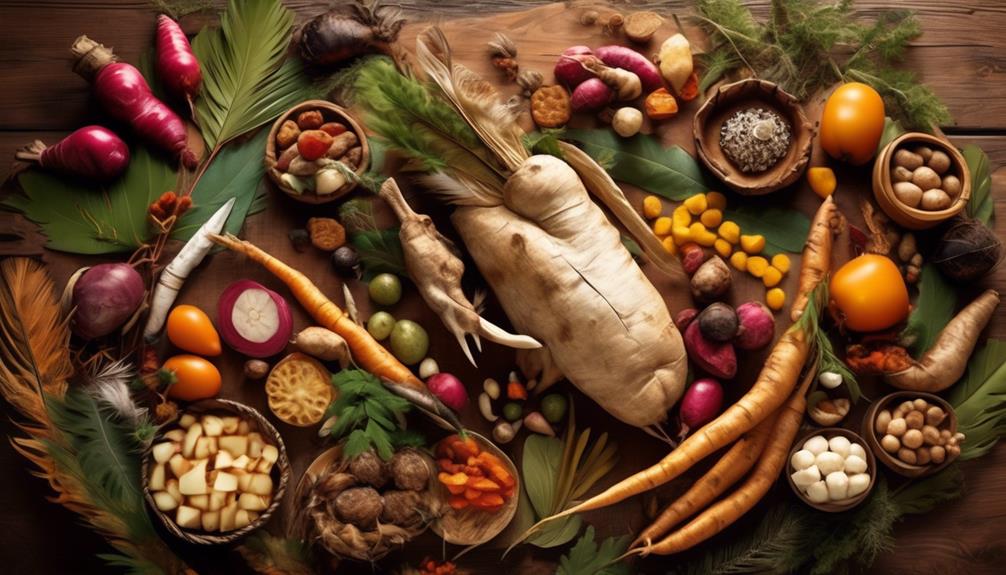We frequently underestimate the varied and nutritious diets of ancient cultures, assuming they were restricted to just a few basic ingredients. Yet, in the case of the Hopi tribe, their culinary customs were strongly connected to the abundant resources of their surroundings.
From cultivating staple crops to hunting and foraging, the Hopi people had a complex and varied diet that sustained their communities for generations.
As we explore the intricacies of their food culture, we'll uncover the fascinating ways in which the Hopi tribe nourished themselves and how their culinary practices were intimately tied to their spiritual beliefs and agricultural expertise.
Key Takeaways
- Corn has been a staple crop for the Hopi tribe for centuries and is used to make dishes such as piki bread and hominy.
- Beans serve as a vital source of protein in the Hopi tribe's diet and were commonly consumed in the form of soups and stews.
- Squash holds a central role in Hopi agricultural practices as it provides natural shade and moisture retention for the soil and is consumed fresh, dried, or as a key ingredient in traditional dishes.
- Hunting, gathering, and foraging traditions provide essential sources of protein and a diverse array of edible and medicinal plants for the Hopi tribe, ensuring a balanced and nutritious diet.
Corn: A Staple Crop
Corn has been a staple crop for the Hopi tribe for centuries, providing sustenance and cultural significance. The tribe has cultivated a diverse range of maize varieties, each with its own unique flavor, texture, and color.
From the vibrant blue Hopi maize to the earthy yellow varieties, the corn holds a special place in the tribe's diet and traditions. The traditional preparation of corn involves a meticulous process of grinding the kernels into fine flour, which is then used to make a variety of dishes such as piki bread, a paper-thin delicacy that requires great skill and precision to make.
The maize is also used in the creation of hominy, a dish where the kernels are soaked and cooked in an alkaline solution, resulting in a distinct flavor and texture.
The Hopi tribe's deep connection with corn is evident in their rituals, ceremonies, and everyday life, showcasing the integral role that this staple crop plays in their cultural heritage.
Beans: Protein Source

Beans serve as a vital source of protein in the Hopi tribe's traditional diet, offering essential nutrients and contributing to the tribe's culinary diversity. The Hopi people have long recognized the nutritional value of beans, which are rich in protein, fiber, and various vitamins and minerals. Beans such as tepary beans and anasazi beans were commonly consumed by the Hopi tribe. The beans were often dried and ground into a fine powder, which was then used to make nutritious soups and stews.
Bean cultivation was an integral part of the Hopi agricultural practices. The tribe carefully tended to their bean crops, cultivating them in the arid desert environment using innovative farming techniques such as terracing and water conservation methods. Additionally, beans weren't only grown for local consumption but also played a crucial role in trade with neighboring tribes, further emphasizing their significance in the Hopi diet and culture.
In terms of cooking, beans were often combined with other staple foods such as corn and squash to create well-balanced meals. They were also prepared in various ways, including boiling, stewing, and even roasting. The versatility of beans in cooking allowed the Hopi tribe to create a wide array of nutritious and flavorful dishes, showcasing their culinary expertise and resourcefulness.
Squash: Farming Importance
Squash, with its vibrant colors and diverse forms, holds a central role in the agricultural practices of the Hopi tribe, contributing to the tribe's sustenance and cultural heritage. The Hopi tribe employs unique farming techniques to cultivate squash, utilizing dry farming methods that are well-suited to their arid environment. The squash plants are interplanted with other crops, providing natural shade and moisture retention for the soil, showcasing the tribe's sustainable agricultural practices.
The nutritional benefits of squash are also significant. The Hopi people have long recognized the high nutritional value of squash, which is rich in essential vitamins and minerals. Its seeds are a good source of protein and healthy fats, complementing the diet that's primarily plant-based. The versatile nature of squash allows for consumption in various forms, including fresh, dried, or as a key ingredient in traditional dishes. Its storage capabilities also make it an essential food source during harsh winters when fresh produce is scarce.
The cultivation and consumption of squash are deeply intertwined with the Hopi tribe's traditions and way of life, exemplifying their profound connection to the land and the sustainable practices that have sustained them for generations.
Meat: Hunting and Gathering

Hunting and gathering play a vital role in the food procurement practices of the Hopi tribe, providing essential sources of protein and nutrients to complement their primarily plant-based diet. The Hopi people utilize a variety of hunting techniques and take advantage of the seasonal availability of different game.
Here's how they do it:
- Game Drives: The Hopi tribe organizes communal hunts, known as game drives, where they strategically guide animals towards designated hunters who wait to take the game down with bows and arrows.
- Small Game Trapping: During the fall and winter, small game such as rabbits and squirrels are trapped using intricately woven snares and nets set along their known paths and feeding grounds.
- Seasonal Adaptation: The Hopi people adjust their hunting techniques based on the seasonal availability of game. In the spring, they focus on migratory birds, while in the summer, they might hunt larger game like deer and elk near water sources.
These hunting techniques and seasonal adaptations enable the Hopi tribe to sustainably gather meat, ensuring a balanced and nutritious diet throughout the year.
Wild Plants: Foraging Traditions
Wild plants are a crucial component of the Hopi tribe's diet, as foraging traditions provide a diverse array of edible and medicinal plants to supplement their food sources. Foraging techniques employed by the Hopi tribe include the gathering of edible roots, which are an essential part of their diet. The tribe has a deep understanding of the different types of edible roots available in their environment and utilizes foraging techniques to ensure a sustainable supply. The Hopi people have passed down knowledge of foraging and identifying these plants from generation to generation, contributing to the preservation of their foraging traditions.
Edible roots such as wild potatoes, onions, and prairie turnips are commonly foraged by the Hopi tribe. These plants not only serve as a source of sustenance but also hold cultural and medicinal significance within the tribe. Foraging for wild plants is a communal activity among the Hopi people, fostering a sense of community and shared responsibility for gathering food. The foraging traditions of the Hopi tribe highlight their deep connection to the land and the importance of sustainable practices in utilizing natural resources.
Frequently Asked Questions
How Did the Hopi Tribe Prepare and Cook Their Food?
We observed the Hopi tribe's food preparation and cooking methods, which involved various traditional techniques. The Hopi people used methods like roasting, boiling, and baking to cook their food. They employed earthenware pots, stone hearths, and open fires for these processes.
The Hopi's cooking methods were a reflection of their resourcefulness and connection to the land, as they utilized locally available ingredients and cooking tools.
Did the Hopi Tribe Have Any Specific Rituals or Ceremonies Related to Food?
Absolutely, the Hopi tribe had a variety of ritual practices related to food. They'd often make food offerings during ceremonies and rituals, symbolizing their connection to the spiritual world.
These offerings were a way for the tribe to express gratitude and seek blessings for their harvests. The rituals surrounding food were deeply ingrained in their culture and played a significant role in their spiritual and communal life.
What Role Did Food Play in Hopi Cultural and Spiritual Practices?
Food held immense cultural significance for the Hopi tribe. Traditional recipes and meals were integral to their spiritual practices and ceremonies, symbolizing their connection to the land and the natural world.
The preparation and consumption of food were deeply intertwined with their cultural identity, reinforcing their values and beliefs. Through these practices, the Hopi people honored their ancestors and maintained a profound spiritual connection to the earth.
How Did the Hopi Tribe Store and Preserve Their Food?
Storing food was crucial for the Hopi tribe. They utilized various food preservation techniques like drying and grinding corn to make it last longer.
The Hopi also stored surplus harvest in ceramic pots, underground pits, and granaries constructed from stone and adobe. These methods helped them ensure a steady food supply throughout the year.
Did the Hopi Tribe Have Any Unique Culinary Traditions or Recipes?
When it comes to Hopi culinary traditions, the tribe is known for its unique recipes that reflect their deep connection to the land and their agricultural practices.
The Hopi people have a rich tradition of preparing corn-based dishes, such as piki bread and hominy stew, as well as utilizing native plants like squash and beans in their cooking.
These culinary traditions are an integral part of their cultural identity and heritage.
Conclusion
In conclusion, the Hopi tribe's diet was diverse and sustainable, consisting of corn, beans, squash, meat, and wild plants.
While some may argue that their diet was limited, it was actually rich in nutrients and flavors.
The Hopi people's deep connection to the land and their farming and foraging traditions allowed them to thrive for centuries, proving that a diet rooted in tradition and respect for the earth can be fulfilling and nourishing.
Mary is a passionate writer who brings creativity and a fresh perspective to our team. Her words have the power to captivate and inspire, making her an essential contributor to our content. Mary’s commitment to storytelling and dedication to promoting Indigenous culture ensures that her work touches the hearts of our readers. We’re fortunate to have her as part of our team.










